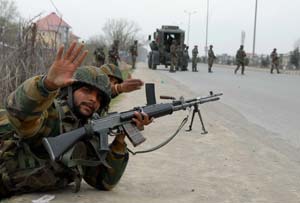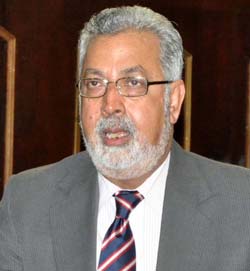“VAAD-I-KHOONAAB”
 “Vaadi -e-khoonaab( The valley of bloodshed )” a compilation of 125 individual stories of the victims killed during 2010 summer uprising was released last week. The book is authored by S Ahmad Peerzada, 33, a resident of Kupwara. The 460-page book written in Urdu and was released on 25th of March.
“Vaadi -e-khoonaab( The valley of bloodshed )” a compilation of 125 individual stories of the victims killed during 2010 summer uprising was released last week. The book is authored by S Ahmad Peerzada, 33, a resident of Kupwara. The 460-page book written in Urdu and was released on 25th of March.
In less than a week’s time half of the first print, around 1000 copies were sold out from different bookstalls in Kashmir.
Profiling all 125 victims and their families struggle for justice and livelihood, Peerzada gives detailed information about the cases which were registered in the aftermath of these killings.
The book talks at length about how families of these victims cope with the trauma. Most of those killed during 2010 uprising were young and sole bread earner for their families. The book highlights the struggle of these families after their loved ones are gone.
The author revisits ‘Machil fake encounter’, which led to start of the 2010 uprising, and gives detail of the victims in full.
The book ends with the photographs of all the people including, four women killed in 2010 by the Police and CRPF. The book is one of the first records of events and killing that has now become part of Kashmiri’s bloodied history.
Peerzada claims to have visited 80 families out of 125 people killed in 2010. “Almost all families are living in acute poverty,” observes Peerzada.
Talking about one such family in Barthana, whose sole bread winner was killed by government forces, is living in extreme poverty. The family is now survived by victims ailing parents, mentally challenged mother and paralysed father, beside his young wife.
During his research Peerzada claims to have found some of the media reports contradicting the information he gathered. He said that many newspapers had reported incorrectly because of the prevailing situations.
Peerzada has self-financed the book. He believes that whatever contribution he did to compile this book is for the future generations, so that they do not remain unaware about what Kashmiris had gone through.
Forces TAMED
 It appears ‘rebels within paramilitary camp’ have been brought under control after CRPF initiated an inquiry against a deputy commandant. The erring official has been alleged involved in inciting his men to speak against the chief minister Omar Abdullah, and create scenes soon after the ‘Fidayeen’ attack at Bemina earlier this month.
It appears ‘rebels within paramilitary camp’ have been brought under control after CRPF initiated an inquiry against a deputy commandant. The erring official has been alleged involved in inciting his men to speak against the chief minister Omar Abdullah, and create scenes soon after the ‘Fidayeen’ attack at Bemina earlier this month.
Sources say director general (DG) CRPF, Pranay Sahay, who arrived in the Valley hours after the attack that led to killing five CRPF men and two militants, has ordered an inquiry.
DG Sahay, as per sources, was briefed about the “scenes created by the deputy commandant of 28 battalion of CRPF Sajwal Singh soon after the encounter ended.”
After the incident district police Srinagar verbally informed the top officials of CRPF about the intentions of their men, as per sources. “Their (CRPF) action could have led to fatalities. Later we conveyed the happenings to senior officials of CRPF. We do not know whether they are holding an inquiry or not,” a police official told local media.
Significantly, CRPF constables who expressed their anger over the absence of chief minister Omar Abdullah at the wreath laying ceremony happen to be the Personal Security Officers (PSOs) of Sajwal.
It was reported soon after the wreath laying ceremony that there was anger among CRPF personnel over absence of chief minister Omar Abdullah and other political leaders at the wreath laying ceremony of their five colleagues killed in Bemina attack.
“We die for the country, but there is no value for our lives. At least the chief minister should have come to see us,” CRPF personnel had told media men that day. “If a civilian dies in stone pelting or during violence they (politicians) go to their house but there is no value for our lives,” they had said.
Later, Omar Abdullah drove to the Airport and laid wreaths on the coffins of the five CRPF men before their bodies were airlifted to Delhi to be taken to their home towns.
Juvenile BILL
State is apparently raising the bar of juveniles in J&K. Earlier this week, the state assembly voted unanimously to raise the juvenile age to 18 years from present 16. Under the new law, J&K would now officially recognize an 18-year old teenager as a minor.
“The juvenile or child means a person who has not completed 18th year of age,” reads the bill. The bill was tabled by the minister for Social Welfare Sakina Ittoo in the legislative assembly last week. “The law is the need of the hour as government aims towards working for betterment of juveniles,” Ittoo told the House.
As per J&K Juvenile Justice Act 1997, children below the age of 16 years were treated juveniles in the state, while in other states, by virtue of the Central Juvenile Justice Act 2000, the cut off age of minors is 18. Government admitted there were lacunae in the Juvenile Justice Act 1997 as it was “insufficient” to meet the requirements necessary for dealing with the children who were in conflict with law.
Significantly, the call for raising the age bar in the J&K gathered support after 2010 summer unrest in the Valley when many children aged 18 and allegedly involved in stone pelting incidents were jailed with routine criminals. Some cases of children being detained under the Public Safety Act (PSA) had also come to the fore.
In 2011, Amnesty International carried a signature campaign in support for increasing the juvenile age in the J&K from 16 to 18 years, urging the Chief Minister Omar Abdullah to bring the state Act at par with international law.
Sources said under the new law the minors involved in acts against law would have to be kept in “special homes” and not in the routine jails. On this front too government was facing criticism for ill treatment of juveniles.
The government would constitute Juvenile Justice Boards in every district, set up Observation Homes for minors according to their age groups and create special Juvenile Police to humanize justice system for children.
Besides, the government would create special juvenile police for handling the cases of juveniles. “In no case a juvenile in conflict with law shall be placed in a lock up or lodged in a jail,” the new law makes it clear.
Swelling BANK
 HDFC bank added more branches this week to its already swelled kitty in a state. Continuing its expansion in the state of J&K, HDFC Bank opened two rural branches at Chadura in the district Budgam and Dooru Shahabad branch in South Kashmir’s district Islamabad.
HDFC bank added more branches this week to its already swelled kitty in a state. Continuing its expansion in the state of J&K, HDFC Bank opened two rural branches at Chadura in the district Budgam and Dooru Shahabad branch in South Kashmir’s district Islamabad.
“The bank has shown tremendous growth in last 2 years and from 10 branches & 20 ATMs in April 2011, we have increased our network to 56 branches and 150 ATMs. This large scale expansion has generated employment avenues to more than 1000 state subjects. During same time bank has also taken CD ratio to 37 per cent,” Zubair Iqbal, vice president and Circle Head, J&K, HDFC Bank said.
He informed that HDFC branch network has raised to 60 by end of March 2013 and ATM network to 160.
Another branch was thrown open at a frontier district of Kupwara this past week which is the first new-generation private sector bank to set up operations in this area.
Amongst the private banks, HDFC Bank currently has the largest network of 57 branches and 151 ATMs in the state.
“We had a modest beginning in the state in the year 2003-04 and since then have proved our commitment to expand in this region.
On Wednesday, HDFC opened another branch at Tral in Pulwama district of South Kashmir.
Threat ALARMS
Kashmir remained on tenterhooks this past week. On Tuesday afternoon, seven policemen including three officers were injured when a detonator went off during defusing of ammunition in Police Station Parimpora.
Police sources said that bomb disposing squad, and police party of police station Parimpora were diffusing live ammunition recovered from two militants killed in Bemina Fidayeen attack on March 13.
The incident created panic in entire Srinagar city and people were seen inquiring from each other about the blast. In Parimpora, traffic was disrupted for at least half an hour after the blast.
A day after this incident, an unidentified gunmen shot at and injured a Panchayat representative in frontier district of Kupwara. Reports said that Noor Ahmad Khan, a deputy sarpanch of Bongam Haihama was attacked by some unidentified attackers, when he was on way to Masjid to offer the Fajar (morning) prayers. But, Police ruled out the role of militants in attack.
Soon after the incident, Khan was removed to sub-district Hospital (SDH) Kupwara. Meanwhile, Police detained two persons and have launched a manhunt for another accused.
But it was the mysterious death of a youth in district Islamabad, Bilal Ahmad Dar, 37, that appeared to worsen the situation. The deceased was a farmer of Munghal village who was found dead in mysterious conditions in a paddy field near railway track in his village
His family alleges that he died in police custody. The police, however, refuted the family claim and said the youth was not picked up by them at all.
Family accounts revealed that he left his house at around 4 pm on Monday to meet his friends. On next day morning, one of their relatives who had gone to the paddy field spotted Dar’s body after which she informed the family. The body, he said, was covered with an empty cement bag.
“Bilal was tortured and killed in police custody,” relatives alleged.
He said that Bilal’s body had visible torture marks and head injuries as well as was confirmed by one of their relatives, doctor by profession, who was present during the post mortem.
However, Senior Superintendent of Police (SSP), Anantnag, R K Jalla said that Dar was not arrested at all. “We had arrested other three persons from Munghal village on Monday at 7:30 pm. However, police didn’t arrest Bilal,” the SSP said.
Wah TAJ
 He is shrewd but complacent too. Having been the only minister in state, who could generate Rs 1000 crores in public exchequer, during his tenure as PHE minister, sword is again lingering on Taj Mohi-ud-Din head. This time, again, for his involvement in the alleged scandal worth crores in the procurement of PHE pipes and CCDU in the PHE Department.
He is shrewd but complacent too. Having been the only minister in state, who could generate Rs 1000 crores in public exchequer, during his tenure as PHE minister, sword is again lingering on Taj Mohi-ud-Din head. This time, again, for his involvement in the alleged scandal worth crores in the procurement of PHE pipes and CCDU in the PHE Department.
It is a setback for Taj as NC lawmakers set their stance opposing him, NC members pressed for announcing a House Committee (HC) to hold thorough probe. The issue was raised by the National Conference member Devender Singh Rana and was supported by Khalid Najeeb Suhrawardy, Dr Bashir Ahmed Veeri and other NC members, when Minister in charge PHE, Irrigation and Flood Control, Sham Lal Sharma (Cong) raised serious allegations in legislative council, regarding the mal-practice and irregularities prevalent in the PHE, I&FC department earlier and alleged that pipes worth crores were purchased without any need.
Now, Taj, the minister of Medical Education and Youth Services has given his nod, by welcoming the demand to constitute a house committee to look into the working and performance of PHE department over the years.
The committee had earlier given Taj a final opportunity to file his defence by or before April 10 over the controversial remarks made by him against the Legislative Council Chairman Amrit Malhotra.
In the last autumn session of assembly Taj was in controversial news for his alleged land grab in Sedov forests in Shopian. An in house panel was formed to look into the matter but later the panel got dissolved.
In the same session, Taj had allegedly leveled serious allegations against Malhotra while terming the constitution of a House panel, for probing land grab charges against him, unconstitutional.
The water usage charges collected from NHPC and other agencies have crossed Rs 1000 crore during the tenure of Taj and it was in his regime that NHPC was told by the state government to adhere to the agreements it has signed with the state from time to time.















